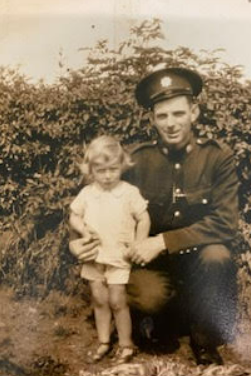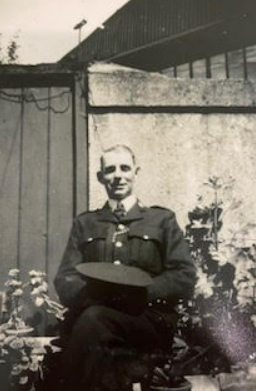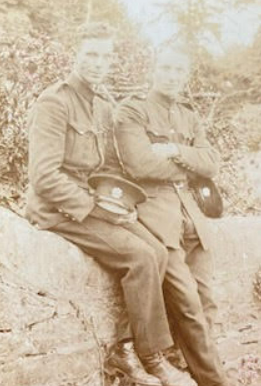About Policing Genealogy Ireland History.
Contents of the Civic Guard Temporary Register 1922-1925
The Register contains a variety of details of the 6,500 Recruits who joined or attempted to join the Civic Guards min its first 3 years. Due to the turbulent times of the newly founded Irish Free State, the first entries are rushed and information regularly crossed out or amended and a lot of information on the first recruits in March 1922 are missing compared to those in April 1922 onwards. The entry for each recruit goes across two pages as seen in other historical ledger books. There are between 30-35 names on average across the two ledger pages. The details of recruits includes:
*Reg Number
*Date of Joining
*Name
*Address
*Date of Birth
*Religion
*IRA Rank
*Ex-Police Rank(RIC or DMP)
*Rank in Foreign Army(e.g. British Army),
*Height(foot and inches),
*Height(foot and inches),
*Chest(inches),
From February 1923 onward the entry of recruits also included the following after IRA rank column…..
*Rank in Irish National Army
In May 1923 onwards also included a height column the following…..
*Knowledge of Irish Language
In August 1923 they also indicated a column between RIC Police Rank and Ex-Foreign Army:
*CID or Protection Corps
Entries of those Civic Guards who were part of ‘Oriel House’ are on page 501 in the last page of the Register and can be found by typing in ‘Oriel House’ in key word search box.
Entries of the dozen men who joined the ‘Civic Guards Band’ all joined between 2 and 4 September 1922 on page 121 of the Register and can be found using the word ‘Band’ in either the keyword search or Reg Number Box on homepage.
The DMP Register
While the DMP Register contains all the 12,000 recruits from 1836 until 1925, this website has focused on only including those of the DMP that were serving when the Civic Guards and DMP amalgamated with An Garda Síochána in 1925. The Register is different to the Civic Guards Temporary Register, It provides more detailed information on the recruits such as previous employment and date of death if they died while serving in the DMP or Gardaí. Similar to Civic Guard Register it is also a ledger book style that does across two pages. Each of the two ledger pages across has about 50 names. The following columns are contained on each recruit:
*Warrant Number
*Date of Birth
*Name
*Religion
*Occupation or Trade (before they joined)
*County, Parish, Post Town (Address)
*Previous Public Service(Name of Service -e.g. N.A. for National Army, and Period of Service e.g. 1 Year 165 Days)
*By Whom Recommended
*Divisions Attached to the Force and dates of Joining Each (e.g. Depot 6 June 1924) -First entry is when they first joined the DMP
*Dates of Joining Forces, Promotion or Reduction to or from the Service Ranks or Classes, Loss of Service, Restoration of Forfeited Service, etc. *Good Service Pay (Date of Appointments Thereto and Deprivation Thereof, etc.)
*Removal from the Force, Cause and Date
*If Re-Appointed, Appointment Warrant When transcribing, points 11 and 12 are instead used in ‘Remarks’ Section’ or ‘Further Notes’ and first entry of Divisions Attached (point 10) is inserted into ‘Date of Joining’ Column. The monetary awards and losses is not used in the transcribing but can be viewed in the original register page.
Further information on Search Results of Irish Garda Recruits
To try and expand on the knowledge of the recruits and individuals in the Civic Guards and later DMP, further columns have been added to the database to facilitate this. This includes for the Civic Guard Recruits the columns in the DMP Register that are not in the 1922-1925 Temporary Register, such as…
*Trade or OccupatioThe DMP Registern
*By Whom Recommended
Additionally, these columns have been added into the website to give more information….
*Where Stationed
*Further Notes (Genealogical information such as parents and date of marriage, date of retirement or death, where buried, etc).
*Page Numbers (Two Register pages for entry)
* Link to Register (Page information comes from)
Keywords (typing in certain words that are related to an entry such as ‘Scott Medal’, ‘Died in Service’, a placename, etc),
Acknowledgements and Sources (Where information and pictures came from such as the family members of the recruit or a book, newspaper article, primary source, etc).
*Images (Main Image of the recruit and up to 3 additional ones such as a family picture or in later career before retirement)
Any member of the DMP can be seen if you put the letters ‘DMP’ into Reg Number box of search, bringing up all members of the DMP. It will appear with the Warrant Number followed by (DMP) in brackets to distinguish between them and the Civic Guard Recruits, for example 10500 (DMP).
Cannot Find your Ancestor in the Police? Here are some reasons why
If a person’s name does not come up, try searching by the surname or address. Even putting in one keyword in address, such as Tipperary, for instance, will bring up addresses of all those whose addresses in Register who were from County Tipperary. The name or address may be unintentionally misspelt and if you contact the website, it can be found for you. This website as a starting point focuses on the Recruits in the Civic Guard Temporary Register and DMP Register so anyone who joins after that is not available in public domain. Family members can contact the website to include their ancestors on the database if they joined 1926 onwards if they have their Reg Number, Pictures and other additional information. If there are any issues or errors in the entries, please contact the admin in the email address or in ‘Contact’ Section of Website and will get back to you as soon as possible.










